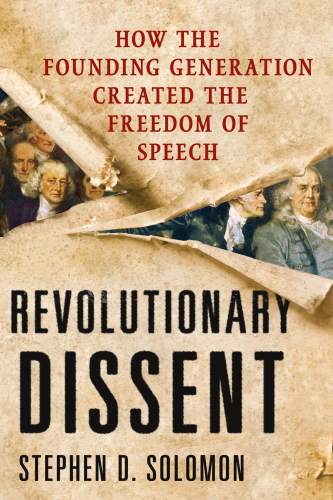
Revolutionary Dissent
How the Founding Generation Created the Freedom of Speech
کتاب های مرتبط
- اطلاعات
- نقد و بررسی
- دیدگاه کاربران
نقد و بررسی

March 21, 2016
Solomon (Ellery’s Protest), a journalist and associate professor at the Arthur L. Carter Journalism Institute at New York University, explores the 17th- and 18th-century political and cultural dynamics that resulted in the expansive view of freedom of expression employed in the U.S. Constitution’s First Amendment. To underscore the breadth of support for this understanding, Solomon cleverly names each chapter after the vocation of a person who played a part in the events that forged the founders’ vision. The players include the famous and the uncelebrated: Paul Revere, the “Silversmith,”; James Madison, the “Framer”; little-known Ebenezer McIntosh, the “Shoemaker”; and Patrick Henry, the “Planter.” Additionally, Solomon demonstrates how broad the concept of freedom of expression had become in the First Amendment, protecting newspapers, pamphlets, songs, and other forms, in addition to public speech. One of the issues, then and now, in First Amendment doctrine is the extent to which libelous speech is protected. Solomon covers this conundrum well and cites a pivotal 20th-century Supreme Court case on freedom of the press, New York Times v. Sullivan, which outlines where the debate now stands. Solomon’s mix of close history, academic dissertation, and accessible popular history reiterates the value of examining the historical precedents to America’s revered commitment to freedom of expression.

February 15, 2016
Accessible study of America's fierce devotion to freedom of speech through the vociferous public reactions to Britain's perceived tyranny. First Amendment scholar Solomon (Arthur L. Carter Journalism Institute, New York Univ.; Ellery's Protest: How One Young Man Defied Tradition and Sparked the Battle over School Prayer, 2007, etc.) spotlights how Colonial citizens and patriots--e.g., minister John Wise, irrepressible newspapers editors, silversmith Paul Revere, farmer John Dickinson, and others--challenged the seditious libel law that the American Colonies had inherited from England. The inherited law prohibited political dissent that would sow discord or slander "between the King and his people" and was aimed at keeping the relationship between sovereign and subject intact. However, as Solomon reveals in orderly chapters, the colonists would not stand by quietly when taxed without self-representation, as first articulated by outspoken Puritan minister Wise in 1687 when he criticized Massachusetts Gov. Edmund Andros for imposing unfair tax policy. Normally, the fines and physical punishment would have been severe. However, with time, the citizen-held juries would not uphold the seditious libel law in court, much to the consternation of chief justice of Massachusetts and governor Thomas Hutchinson when trying to silence the radical Boston Gazette publishers, Benjamin Edes and John Gill, from criticizing him in an important case in 1767. Solomon looks at the rise of newspapers, "coffeehouse culture," broadsides, political theater, cartoons, and even symbols such as effigies and the Liberty Tree in Boston as significant in whipping up public foment. They were all part of the Enlightenment convictions held by the framers that citizens of a democracy "required the freedom to speak freely and passionately on all the issues before them." While the early American revolutionaries revered their freedom of expression as part of their patriotic duty, the subsequent legal challenges severely undermined those early libertarian impulses. Solomon follows the First Amendment arguments to the present. A cogent, organized history of the beginnings of free speech in the United States.
COPYRIGHT(2016) Kirkus Reviews, ALL RIGHTS RESERVED.

























دیدگاه کاربران